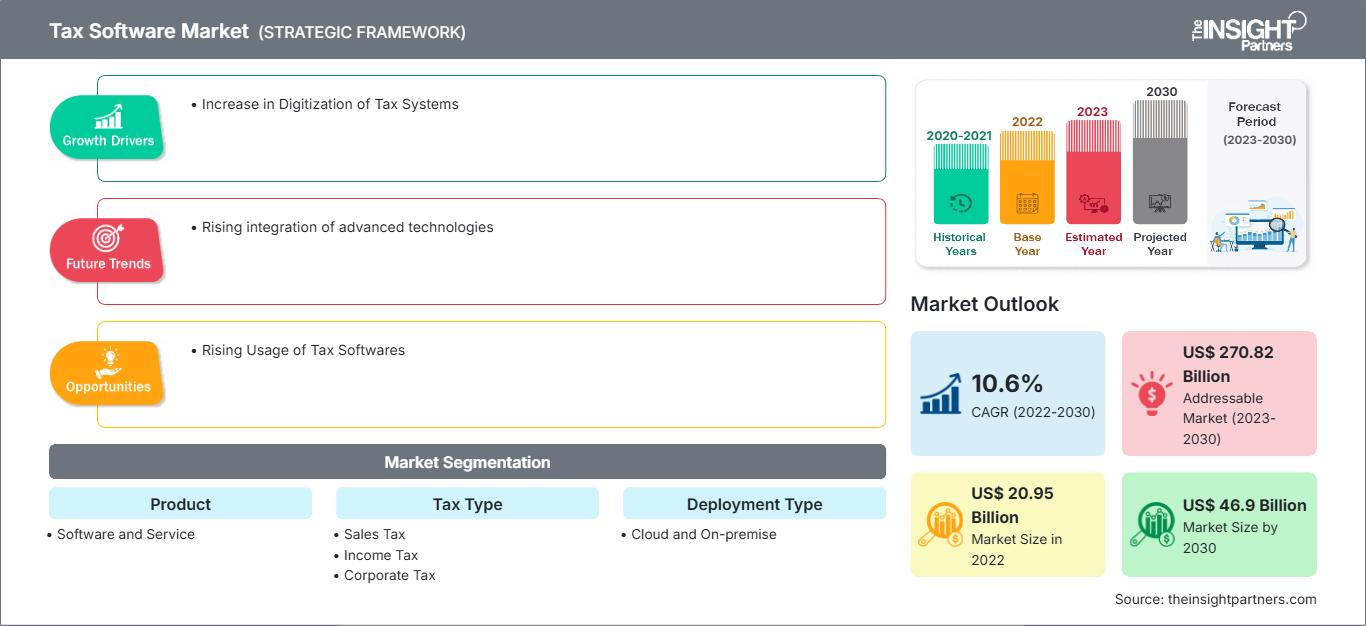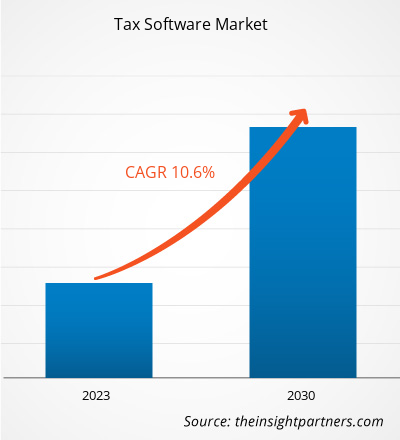2022年,税务软件市场规模为209.5亿美元,预计到2030年将达到469亿美元。预计2022年至2030年,税务软件市场的复合年增长率将达到10.6%。先进技术的日益融合很可能仍将是市场的主要趋势。
税务软件市场分析
税务软件市场的主要参与者正在推出软件和服务,以节省客户的税款。他们利用自动化技术简化各种规模企业的销售税。例如,2023年8月,面向企业的金融基础设施平台Stripe推出了Stripe Tax for Platforms,使使用Stripe Connect的平台能够将Stripe Tax作为一项服务提供给其客户。Stripe Tax是支付处理的合理延伸,Stripe构建了Tax for Platforms,以便平台可以将其提供给客户,并帮助他们处理交易生命周期的各个方面。此类产品的发布有助于推动全球税务软件服务的采用。2023年5月,智能销售税解决方案公司CereTax, Inc.发布了新的用户界面,以简化销售税自动化流程。用户可以使用新网站(CereTax云端税务自动化平台的组成部分)管理和自动化其销售税操作,包括税务计算、严格规则和深入报告。由于界面简洁易用,各种规模的企业都能高效无阻地运营。此类产品的发布有助于推动全球税务软件解决方案的采用。
税务软件市场概览
税务软件平台可以成为许多纳税人申报纳税申报表的绝佳资源。它旨在提高纳税申报流程的效率,并帮助普通纳税人了解税法的各种细微差别。税务软件的主要目的是实现纳税申报流程的自动化。税务软件具有多种功能,包括电子申报,这是一种更安全、减少错误和处理时间的方法。许多税务软件程序会将纳税申报表存储在云端数年,以便企业在报税时可以轻松访问它们。
自定义此报告以满足您的要求
您将免费获得任何报告的定制,包括本报告的部分内容,或国家级分析、Excel 数据包,以及为初创企业和大学提供超值优惠和折扣
税务软件市场: 战略洞察

- 获取本报告的主要市场趋势。这个免费样本将包括数据分析,从市场趋势到估计和预测。
您将免费获得任何报告的定制,包括本报告的部分内容,或国家级分析、Excel 数据包,以及为初创企业和大学提供超值优惠和折扣
税务软件市场: 战略洞察

- 获取本报告的主要市场趋势。这个免费样本将包括数据分析,从市场趋势到估计和预测。
税务软件市场驱动力与机遇
税务系统数字化程度提升,利好市场
持续的数字革命为企业带来了巨大的发展空间——数字服务和自动化有助于改变商业模式和传统流程,从而提高运营效率和收入。企业的数字化转型或自动化是指将数字技术融入各种业务流程、组织活动和商业模式。税务系统数字化有助于提高运营效率、优化端到端业务流程,并减少成本和人为错误。
税务软件使用率上升
税务软件市场在过去几年中增长强劲,其中一个主要驱动因素是税务软件系统的数字化。由于技术的进步以及企业对精简高效的税务流程日益增长的需求,对数字化解决方案的需求呈螺旋式上升,旨在简化所有与税务相关的活动。任何税务软件系统的数字化都能为各种规模的企业和个人带来诸多益处。其中一大优势是所有税务相关任务的自动化。这减少了人工工作量,从而将出错的可能性降至最低。通过税务软件,数据录入、税务计算和报告可以实现自动化,确保准确性并符合税法规定。
税务软件市场报告细分分析
促成税务软件市场分析的关键细分领域包括产品、部署类型、税种、企业规模、行业和最终用户。
- 根据组成部分,全球税务软件市场可细分为软件和服务。软件领域在2022年占据了市场主导地位。
- 根据税种,税务软件市场可分为销售税、所得税、公司税和其他税种。 2022 年,销售税细分市场占据了市场主导地位。
- 根据最终用户类型,税务软件市场分为个人和商业。2022 年,商业细分市场占据了市场主导地位。
- 根据企业规模,市场细分为小型、中型和大型企业。2022 年,大型企业细分市场占据了市场主导地位。
- 根据垂直行业,商业企业市场分为 BFSI、政府、IT 和电信、医疗保健、零售和其他。2022 年,BFSI 细分市场占据了市场主导地位。
按地区划分的税务软件市场份额分析
税务软件市场报告的地理范围主要分为五个区域:北美、亚太地区、欧洲、中东和非洲以及南非。中美洲。
2022年,北美占据了市场主导地位。该地区在软件解决方案的采用方面已发展成熟。例如,根据Employbl Inc.的数据,截至2023年8月,全美共有超过6,727家软件公司。Avalara、Sage Group Plc、汤森路透集团和Xero Ltd等众多税务软件提供商为个人和企业提供先进的税务软件解决方案,帮助他们高效、无误地完成报税流程。因此,几家领先的税务软件提供商的存在正在积极推动北美税务软件市场的增长。劳动力短缺的企业更专注于采用技术来改进运营和工作流程,而不是雇佣熟练的劳动力。他们正在学习采用人工智能 (AI) 解决方案。因此,个人和专业人士对人工智能解决方案的认知度和普及度不断提高,这推动了基于人工智能的税务软件解决方案的采用。
税务软件市场税务软件市场
The Insight Partners 的分析师已详尽阐述了预测期内影响税务软件市场的区域趋势和因素。本节还讨论了北美、欧洲、亚太地区、中东和非洲以及南美和中美洲的税务软件市场细分和地域分布。
税务软件市场报告范围
| 报告属性 | 细节 |
|---|---|
| 市场规模 2022 | US$ 20.95 Billion |
| 市场规模 2030 | US$ 46.9 Billion |
| 全球复合年增长率 (2022 - 2030) | 10.6% |
| 历史数据 | 2020-2021 |
| 预测期 | 2023-2030 |
| 涵盖的领域 |
By 产品
|
| 覆盖地区和国家 | 北美
|
| 市场领导者和主要公司简介 |
|
税务软件市场参与者密度:了解其对业务动态的影响
税务软件市场正在快速增长,这得益于终端用户需求的不断增长,而这些需求的驱动因素包括消费者偏好的不断变化、技术进步以及对产品优势的认知度不断提高。随着需求的增长,企业正在扩展其产品线,不断创新以满足消费者需求,并利用新兴趋势,从而进一步推动市场增长。

- 获取 税务软件市场 主要参与者概述
税务软件市场新闻和最新发展
税务软件市场通过收集一手和二手研究后的定性和定量数据进行评估,这些数据包括重要的公司出版物、协会数据和数据库。税务软件市场的一些发展如下:
- Right Networks 是一家为会计师事务所和专业人士提供专用智能云服务的公司,该公司与全球内容和技术公司汤森路透合作,在美国提供其税务和会计解决方案的云托管服务。(来源:Right Networks,新闻稿,2023 年 8 月)
- 汤森路透宣布,计划从明年开始每年在人工智能 (AI) 方面投资 1 亿美元,并计划将技术整合到其税务研究和税务准备系统以及其他领域。 (来源:汤森路透,新闻稿,2023 年 7 月)
税务软件市场报告覆盖范围和交付成果
“税务软件市场规模和预测(2020 年–2030 年)”报告对市场进行了详细的分析,涵盖以下领域:
- 税务软件市场规模以及涵盖范围内所有关键细分市场的全球、区域和国家/地区预测
- 税务软件市场趋势以及市场动态,例如驱动因素、限制因素和关键机遇
- 详细的 PEST/Porter 五力模型和 SWOT 分析
- 税务软件市场分析涵盖关键市场趋势、全球和区域框架、主要参与者、法规和最新市场发展
- 行业格局和竞争分析涵盖市场集中度、热图分析、知名参与者和超导市场的最新发展
- 详细的公司简介
- 历史分析(2 年)、基准年、预测(7 年)及复合年增长率
- PEST和SWOT分析
- 市场规模、价值/数量 - 全球、区域、国家
- 行业和竞争格局
- Excel 数据集
近期报告
相关报告
客户评价
购买理由
- 明智的决策
- 了解市场动态
- 竞争分析
- 客户洞察
- 市场预测
- 风险规避
- 战略规划
- 投资论证
- 识别新兴市场
- 优化营销策略
- 提升运营效率
- 顺应监管趋势






















 获取免费样品 - 税务软件市场
获取免费样品 - 税务软件市场